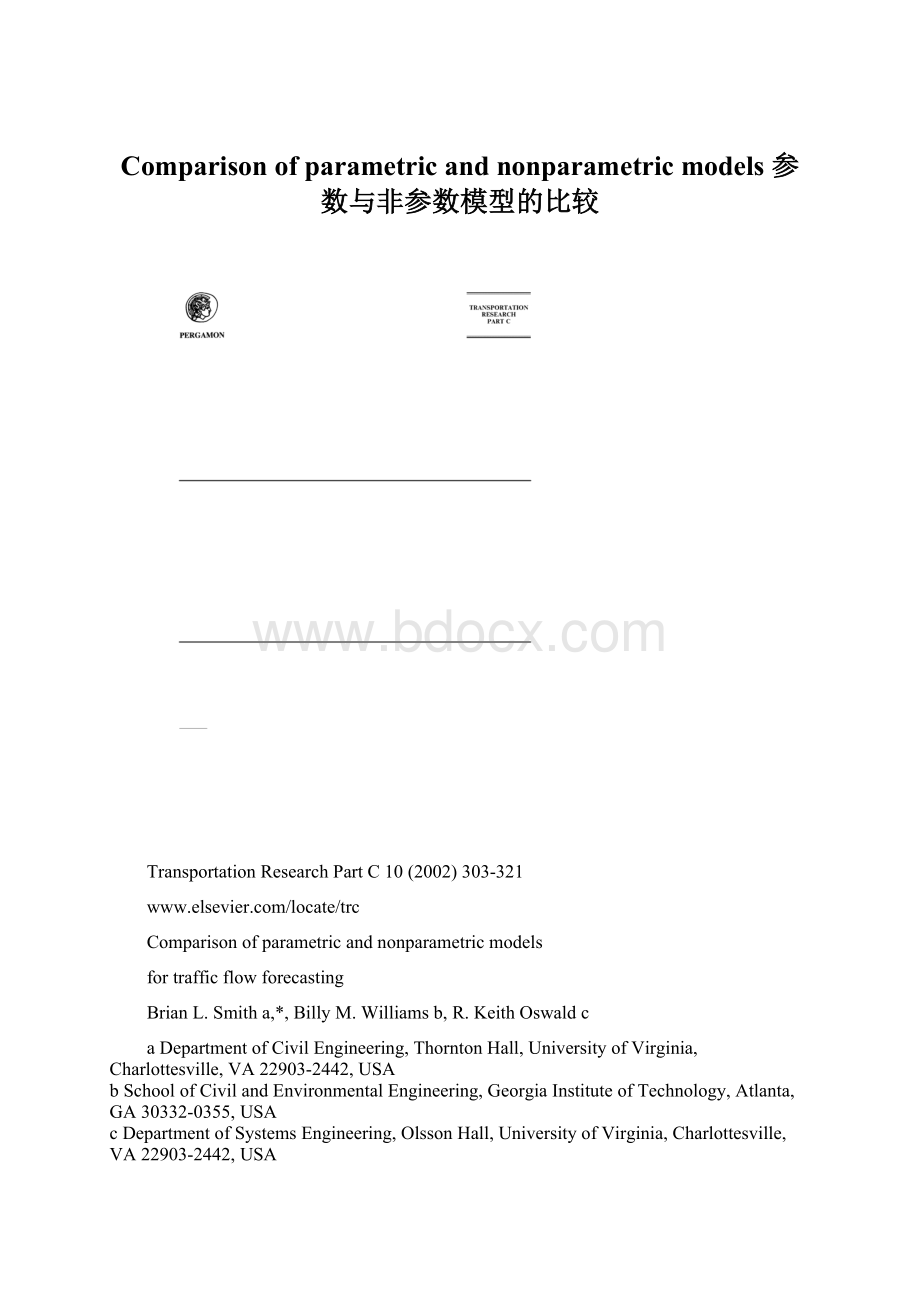 Comparison of parametric and nonparametric models 参数与非参数模型的比较Word文件下载.docx
Comparison of parametric and nonparametric models 参数与非参数模型的比较Word文件下载.docx
- 文档编号:18365217
- 上传时间:2022-12-15
- 格式:DOCX
- 页数:27
- 大小:346.46KB
Comparison of parametric and nonparametric models 参数与非参数模型的比较Word文件下载.docx
《Comparison of parametric and nonparametric models 参数与非参数模型的比较Word文件下载.docx》由会员分享,可在线阅读,更多相关《Comparison of parametric and nonparametric models 参数与非参数模型的比较Word文件下载.docx(27页珍藏版)》请在冰豆网上搜索。

cDepartmentofSystemsEngineering,OlssonHall,UniversityofVirginia,Charlottesville,VA22903-2442,USA
Received12July1999;
accepted5July2001
Abstract
Singlepointshort-termtrafficflowforecastingwillplayakeyroleinsupportingdemandforecastsneeded
byoperationalnetworkmodels.Seasonalautoregressiveintegratedmovingaverage(ARIMA),aclassic
parametricmodelingapproachtotimeseries,andnonparametricregressionmodelshavebeenproposedas
wellsuitedforapplicationtosinglepointshort-termtrafficflowforecasting.Pastresearchhasshownsea-
sonalARIMAmodelstodeliverresultsthatarestatisticallysuperiortobasicimplementationsofnon-
parametricregression.However,theadvantagesassociatedwithadata-drivennonparametricforecasting
approachmotivatefurtherinvestigationofrefinednonparametricforecastingmethods.Followingthismo-
tivation,thisresearcheffortseekstoexaminethetheoreticalfoundationofnonparametricregressionandto
answerthequestionofwhethernonparametricregressionbasedonheuristicallyimprovedforecastgener-
ationmethodsapproachthesingleintervaltrafficflowpredictionperformanceofseasonalARIMAmodels.
2002ElsevierScienceLtd.Allrightsreserved.
Keywords:
Trafficforecasting;
Nonparametricregression;
ARIMAmodels;
Motorwayflows;
Short-termtrafficprediction;
Statisticalforecasting
1.Introduction
Asintelligenttransportationsystems(ITS)areimplementedwidelythroughouttheworld,
managersoftransportationsystemshaveaccesstolargeamountsof‘‘real-time’’statusdata.
Whilethisdataiskey,ithasbeenrecognizedbyresearchersandpractitionersalikethatthefull
*Correspondingauthor.Tel.:
+1-434-243-8585;
fax:
+1-434-982-2951.
E-mailaddress:
briansmith@virginia.edu(B.L.Smith).
0968-090X/02/$-seefrontmatter2002ElsevierScienceLtd.Allrightsreserved.
PII:
S0968-090X(02)00009-8
304B.L.Smithetal./TransportationResearchPartC10(2002)303-321
benefitsofITScannotberealizedwithoutanabilitytoanticipatetrafficconditionsintheshort-
term(lessthanonehourintothefuture).Thedevelopmentoftrafficconditionforecastingmodels
willprovidethisability,andsupportproactivetransportationmanagementandcomprehensive
travellerinformationservices.Whatdistinguishestrafficconditionforecastingfromthemore
traditionalforecastsoftransportationplanningisthelengthofthepredictionhorizon.While
planningmodelsusesocioeconomicdataandtrendstoforecastoveraperiodofyears,traffic
conditionforecastingmodelspredictconditionswithinthehourusingdatafromroadwaysensors.
Withoutapredictivecapability,ITSwillprovideservicesinareactivemanner.Inotherwords,
therewillbealagbetweenthecollectionofdataandtheimplementationoftrafficcontrolstrat-
egies.Therefore,thesystemwillbecontrolledbasedonoldinformation.Inordertocontrolthesysteminaproactivemanner,ITSmusthaveapredictivecapability.‘‘Theabilitytomakeandcontinuouslyupdatepredictionsoftrafficflowsandlinktimesforseveralminutesintothefutureusingreal-timedataisamajorrequirementforprovidingdynamictrafficcontrol’’(Cheslowetal.,1992).Furthermore,trafficconditionforecastingisimportantintravellerinformationsystems.Thisis
illustratedinthestatement,‘‘therationalebehindusingpredictiveinformation(forrouteguidance)
isthattraveller’sdecisionsareaffectedbyfuturetrafficconditionsexpectedtobeineffectwhentheyreachdownstreamsectionsofthenetwork’’(Kaysietal.,1993).Infact,currenttravellerinfor-
mationactivitiesarebeinghamperedbythelackofacapabilitytopredictfuturetrafficconditions.
1.1.Transportationconditionforecasting
Predictingfuturetrafficconditionsisageneralconcept.Infact,thereareawidevarietyofneedsforconditionforecastsdependingonparticularapplications.Forexample,forecastsoftrafficflow,speed,traveltime,andqueuelengtharerequiredforspecifictransportationmanagementapplications.Furthermore,itiscertainlytruethatfuturetrafficconditionswillbedependentontransportationmanagementstrategiesemployed,andthattrafficflowcanbetracked,givenasufficientnumberandplacementofsensors,asitprogressesthroughanetwork.Forthesereasons,anidealapproachtotrafficconditionforecastingisanetwork-basedmodelthatsimulatesthesystemasitrespondstotransportationmanagementstrategies.Inotherwords,amodelthattakesadvantageofspatialinformationandtrafficflowdynamics.
However,everynetworkmusthaveboundarypoints,locationsthatserveasentry‘‘nodes’’to
thenetworkthatdonothavetheadvantageofupstreamdetectorstouseinpredictingtheirstate.
Infact,anydynamictrafficnetworkmodels,suchascommonlyusedsimulationmodels(for
example,CORSIM),are‘‘driven’’bythetrafficflowrate(usuallyinvehiclesperhour)atthese
boundarypoints.Inessence,theboundarypointsdefinetheshort-termdemandfortravelthrough
thenetwork.Forthisreason,animportantsubsetoftrafficconditionforecastingistheabilityto
predictfuturetrafficflowatalocation(aboundarypoint),givenonlydatadescribingpast
conditionsatthispoint.Theresearchdescribedinthispaperaddressesthisspecificchallengeof
singlepointtrafficflowprediction.
Basedonthisdefinitionoftheproblem,onewillnotethatsinglepointtrafficflowpredictioncan
bedescribedasatimeseriesproblem.Givenaseriesofpastflowreadingsmeasuredinregular
intervals,amodelisdesiredtopredicttheflowatthenextinterval.Thus,weconsiderthedemand
fortravel(measuredbyflow)atapointtobeadynamicsystem,whichbydefinitionconsistsoftwo
parts:
astate,ortheessentialinformationdescribingthesystem,andadynamic,whichistherule
B.L.Smithetal./TransportationResearchPartC10(2002)303-321305
thatgovernshowthestatechangesovertime(MulhernandCaprara,1994).Adynamicsystem
evolvestowardsanattractor,whichisthesetofvaluestowhichthesystemeventuallysettles
(Thearling,1995).Dynamicsystemsareoftencomplexduetochaoticattractors,whichhavea
boundedpaththatisfullydetermined,yetneverrecurs(MulhernandCaprara,1994).Thepresence
ofchaoticattractorstendstocloudthedistinctionbetweendeterministicandstochasticbehavior,
andmakestheselectionofanidealmodelingapproachdifficult.Aconsiderableamountofresearch
hasaddresseddynamicsystemmodelinginareassuchasfluidturbulence(Takens,1981),disease
cases(SugiharaandMay,1990),andmarketing(MulhernandCaprara,1994).Inaddition,this
areahasseenalargelevelofinterestinthetransportationresearchcommunityoflate.
Whenevaluatingdynamicsystemsmodelsfortrafficflowforecasting,itiscertainlyimportanttoconsidertheaccuracyofthemodel.However,itisequallyimportanttoconsidertheenvironmentinwhichthemodelwillbedeveloped,used,andmaintained.Intelligenttransportationsystemsdeployedinmetropolitanregionsincludethousandsoftrafficdetectors.Forexample,intheHamptonRoadsregionofVirginia,amoderate-sizedmetropolitanarea,thestatedepartmentoftransportationisintheprocessofinstallingover1200sensorstationsonthefreewaysalone.Inaddition,thedepartment,likemostothers,facesseverepersonnelshortages.Asaresult,modelsthatrequiresignificantexpertiseandtimetocalibrateandmaintain,onasite-by-sitebasis,aresimplyinfeasibleforuseinthisenvironment.Therefore,onemustexplicitlyconsidertherequirementsfordynamicsystemmodelcalibrationandmaintenance.
1.2.Modelingapproaches
Predictingtrafficflowatapointdecomposesintoatime-seriesmodelingprobleminwhichoneattemptstopredictthevalueofavariablebasedonaseriesofpastsamplesofthevariableatregularintervals.Timeseriesmodelshavebeenstudiedinmanydisciplines,includingtransportation.Inparticular,transportationresearchershavedevelopedtimeseriestrafficpredictionmodelsusingtechniquessuchasautoregressiveintegratedmovingaverage(ARIMA),nonparametricregression,neuralnetworks,andheuristics.AcompletereviewoftransportationapplicationsinthisareacanbefoundinSmith(1995)andWilliams(1999).
RecentresearchbyWilliams(1999)hasappliedtraditionalparametricBox-Jenkinstimeseries
modelstothedynamicsystemofsinglepointtrafficflowforecasting.Thisworkhasaddressed
mostoftheparametricmodelconcernsfortrafficconditiondatabyestablishingatheoretical
foundationforusingseasonalARIMAforecastmodels(seeSection3.3).ARIMAforecasting
isfoundedinstochasticsystemtheory.ARIMAprocessesarenondeterministicwithlinearstate
transitionsandcanbeperiodicwiththeperiodicityaccountedforthroughseasonaldifferencing.
Thereare,however,somesignificantconcernswiththeabilitytofitandmaintainseasonalARIMAmodelsona‘‘production’’basisinITSsystems,giventhelevelofexpertiseandamountoftimerequiredtodoso.Forexample,theresearchersrec
- 配套讲稿:
如PPT文件的首页显示word图标,表示该PPT已包含配套word讲稿。双击word图标可打开word文档。
- 特殊限制:
部分文档作品中含有的国旗、国徽等图片,仅作为作品整体效果示例展示,禁止商用。设计者仅对作品中独创性部分享有著作权。
- 关 键 词:
- Comparison of parametric and nonparametric models 参数与非参数模型的比较 参数 模型 比较
 冰豆网所有资源均是用户自行上传分享,仅供网友学习交流,未经上传用户书面授权,请勿作他用。
冰豆网所有资源均是用户自行上传分享,仅供网友学习交流,未经上传用户书面授权,请勿作他用。
链接地址:https://www.bdocx.com/doc/18365217.html


 如何打造酒店企业文化2刘田江doc.docx
如何打造酒店企业文化2刘田江doc.docx
